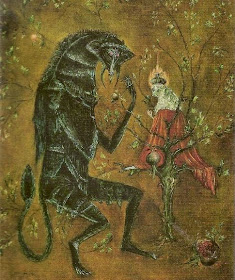I've talked before about how I don't handle reaction rolls well. Basic has two regular 2d6 rolls the GM makes: reaction rolls and Morale.
MAPS, BOSSES, INTELLIGENCE
Where I'm coming down on this has to do with map and proximity.
Sufficiently intelligent NPCs (say, anything above animal intelligence) have their behavior largely determined by their position on the map and their relative proximity to "dangerous areas" and "bosses."
Bosses, in this case being named/senior NPCs who are likely interested in and in the position to boss around other NPCs ("named" being obvious, "senior" being the designated leader based on the edition's distributions (for every x of y there is a +1HD +1 Damage version of y) or maybe just even a superior hp roll (the one orc with max hp in a level of middling hp orc). You act right and proper when the boss is around.
Dangerous areas being points of ingress/egress from what the NPC considers "my place" and the "not my place" parts of the dungeon and pretty much everywhere in the Wilderness. You act tough and alert when your life depends on it.
Outside of this context, reasonably intelligent NPC are doing the things reasonably intelligent NPCs do: they're eating, lounging, arguing, gaming, painting, torturing something, masturbating, reading, playing with their kids, having sex, etc. You can make a list of these depending on the type of enemy or their culture, etc. You then tick off each entry on the list as you encounter more enemies (the first ones are eating, second ones are lounging, etc); if you do it this way, repeat actions that feel more common or likely.
WHAT YOU CAN DO WITH THEM
The party encounters some goblins pulling the wings off moths and playing a dice game.
The PCs are inside goblin territory. They don't necessarily appear as threats to the goblins and, the goblins not being on guard duty or being near an authority figure, don't really have any obligations to fulfill. They leap for weapons and watch the characters (neither groups were surprised) warily.
The players can then choose to attack, but they can also choose to talk. Interpret what the players ask as the goblins: they are saying things. what do those things ask of "us"?
If the players are bluffing, pretending to be allies and that's a reasonable thing for them to do in this context, then you roll a 2d6. If you beat the goblin's morale (7), the goblins buy it. If you don't, they don't.
Moldvay even accommodates situations in which parley still feels appropriate, even around a "boss" type (say, negotiating with surprised or overwhelmed opponents). Just add 2 to their Morale.
AESTHETIC
Morale is employed as a metric in the older Basics of how likely a character is to break and run or crumple and plead for mercy when the swords came out and allies died.
Fundamentally, the idea here is that the mechanics and fictional positioning conspire to make the game inherently opposed to the characters where it ought to be and more plastic where that makes more sense too. It asks more of GMs (who will need to determine if creatures attack immediately or not), but also much less (how easy it is to push NPCs around). As with any tweak like this, it smooths edges that are often satisfyingly uneven, but so far it's worked pleasingly (it also creates some rough edges of its own.
5e with DCs or NOT
Personally, I'd go with not. I've got a lot of experience with Moldvay and remembering or extrapolating morale scores is pretty easy. Goblins in Moldvay have a morale of 7 (58% chance of success or roughly, a DC10) unless there is a boss around, in which case it's 9 (30% chance or DC15).
An 8 morale means PCs doing a good job have a 45% chance of success (DC12).
A 10 Morale means PCs doing a good job have a 17% chance (DC17).
attribution: Leonora Carrington

No comments:
Post a Comment